It’s true, NO ONE wants to have any sort of weeds growing in their lawn.
They are a nuisance, and they are typically quite unsightly.
However, there are actually different types of weeds. Additionally, there are different types of weeds that grow in different areas of the country. These weeds all have very different characteristics.
Some are very unsightly, but others actually have flowers or other uses!
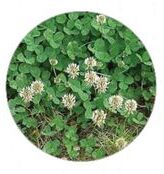 1. White Clover
1. White Clover
A very common weed in most of the United States, except the deep south, is White Clover. White Clover has white flower-like tops. However, the "flowers" do not have traditional petals.
Their petals are actually quite pointy looking and numerous, and they form a round formation at the top of the plant. These also have distinctive clover leaves. Most of these have three leaves. However, a very small number of them have four leaves.
Traditionally, finding a four leafed clover is seen as an omen of good luck!
Identifying White Clover (Trifolium repens):
- Leaves: Each leaf has three oval leaflets, often with a distinctive white crescent or "watermark".
- Flowers: Small, white, and globe-shaped, appearing between late spring and early autumn.
- Height: Typically grows close to the ground, no more than a few inches high.
- Growth Pattern: Spreads through creeping stems that root at the nodes.
Pros of White Clover:
- Nitrogen Fixation: White clover enriches the soil by adding nitrogen, boosting fertility.
- Drought Tolerance: Once established, white clover requires less watering.
- Pollinator Friendly: It attracts bees and other pollinators, enhancing garden biodiversity.
- Lawn Aesthetic: Improves lawn appearance by filling sparse areas and reducing the need for fertilizers.
Cons of White Clover:
- Invasiveness: It can spread aggressively, outcompeting other plants in lawns and gardens.
- Allergies: The pollen may significantly affect those with allergies.
- Maintenance: Needs consistent management to control spreading.
 2. Yarrow
2. YarrowIn all of the United States except Florida, a weed called Yarrow grows. Yarrow has small white flowers attached to stalks.
It can also have other colored flowers, such as pink and red. It is actually used in herbal medicine. Additionally, yarrow is an additive to some liquors.
Yarrow Identification:
- Leaves: Finely divided, feathery appearance, resembling ferns.
- Flowers: Small, white to pink, clustered in flat-topped arrays.
- Stem: Erect, can reach up to 3 feet in height, generally hairy.
- Root System: Deep and extensive, spreads by rhizomes.
Pros of Yarrow:
- Medicinal Uses: Historically, yarrow has been used for its healing properties, particularly in wound care.
- Drought Resistance: Yarrow thrives in dry conditions, requiring minimal watering.
- Soil Improvement: Helps break up compact soil, enhancing soil structure.
- Attracts Beneficial Insects: Supports biodiversity by attracting pollinators like bees and butterflies.
Cons of Yarrow:
- Invasiveness: Can spread aggressively, out-competing native plants in gardens and wild areas.
- Allergenic Pollen: May trigger allergies in sensitive individuals.
- Maintenance: Requires regular maintenance to prevent over-spreading in garden settings.
- Toxicity: Can be toxic to pets if ingested in large quantities.
 3. Witchgrass
3. Witchgrass
Another common weed is witchgrass. This weed is rather unsightly, and it has many small buds on thin projections coming out of a stalk. When conditions are right, this plant can become a "tumbleweed".
When conditions become dry, the small buds and the thin projections attached to them break off from the main part of the plant. These projections then blow around.
Pros of Witchgrass:
- Adaptability: It thrives in a variety of soil conditions, including poor soils.
- Wildlife Support: Provides habitat and food for birds and small mammals.
Cons of Witchgrass:
- Invasiveness: Witchgrass can quickly spread and dominate, overshadowing desired plants in gardens and lawns.
- Maintenance: It is difficult to eradicate due to its rapid growth and prolific seed production.
- Agricultural Impact: Witchgrass competes with crops for nutrients and water, potentially reducing yields.
 4. Speedwell
4. Speedwell
Speedwell is another weed that grows in many areas. However, this is restricted to the east coast to the north of Virginia. This plant has flowers that grow off of it, and it is typically not too unsightly.
In fact, speedwell is sometimes planted as an ornamental plant. However, it obviously appears distinctly different from the lawn itself.
How can I tell if a plant is speedwell?
Identifying Speedwell:
- Appearance: Low-growing, creeping plant with small, rounded leaves.
- Flowers: Typically small, they feature four petals and appear in hues of blue, violet, white, or pink. They grow in clusters, either as racemes or spikes.
How does speedwell benefit the environment?
Speedwell benefits the environment in several ways:
- Aesthetic Appeal: Its attractive flowers add a splash of color to lawns and gardens.
- Pollinator Friendly: It attracts hummingbirds and other pollinators, enhancing biodiversity.
- Versatility: Its mat-forming growth makes it an excellent ground cover option.
How do I control the spread of speedwell?
Speedwell can be a persistent weed, but with the right strategies, you can keep it in check.
Here are effective methods:
- Hand-pulling: Effective for small patches, especially young plants.
- Mulching: A thick layer of mulch can suppress seedlings and limit spread.
- Pre-emergent herbicides: May prevent speedwell seeds from germinating.
- Post-emergent herbicides: Use with caution, may harm desirable plants.
 5. Quackgrass
5. Quackgrass
Quackgrass is also extremely common. This grass looks just as the name suggests. It is a form of grass, but it is very different from what you want in your lawn. It tends to be quite tall, with chutes coming out of the top.
This grass is all over in the United States, except for Arizona and Florida.
In fact, it even grows as far north as the arctic!
How do you identify quackgrass?
Quackgrass is a persistent weed with the following key characteristics:
- Leaves: Blue-green, broad, flat, and rough-textured. Look for a short, translucent membrane (ligule) where the leaf blade meets the stem, along with claw-like auricles that clasp the stem.
- Stems: Sturdy, hollow, and capable of growing up to 4 feet tall.
- Roots: Extensive, whitish rhizome system (underground stems) that spreads aggressively.
What is quackgrass used for?
Primarily considered a weed, quackgrass is sometimes utilized for erosion control due to its rapid growth and extensive root system. In certain scenarios, it can also serve as forage for livestock.
- Erosion Control: Quackgrass is often employed to stabilize soil and prevent erosion thanks to its dense and far-reaching root system.
- Forage: It serves as forage for livestock, offering a decent source of nutrition for grazing animals.
- Wildlife Habitat: This grass provides cover and habitat for various wildlife species.
- Weed Suppression: Its aggressive growth can help suppress other weeds, although it can itself become a problematic weed.
How to control quackgrass?
Control involves a combination of manual removal (digging out the extensive root system), the use of herbicides (like glyphosate), and maintaining healthy, dense turf to prevent its spread.
What is the difference between quackgrass and crabgrass?
These two grassy weeds can be a pain, but there are ways to tell them apart:
| Feature | Quackgrass | Crabgrass |
|---|---|---|
| Origin | Perennial (returns yearly) | Annual (grows from seeds each year) |
| Root System | Deep, with rhizomes | Shallow, easier to pull out |
| Blade Features | Wider, rough texture, prominent midrib | Narrower, smoother |
| Growth Pattern | Grows in clumps from the roots | Spreads outwards, forming mats |
| Seasonality | Emerges in early spring, lasts through fall | Germinates in late spring, dies with frost |
| Seed Head | Spike-like, similar to wheat or rye | Finger-like, radiating from center |
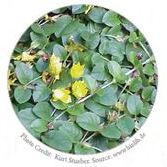 6. Moneywort
6. Moneywort
Moneywort is a common weed in all areas except the northern plains. This weed is quite common, but it stays low to the ground.
For this reason, it is sometimes not as easily noticed. It has dark, rounded leaves. Sometimes, it can flower yellow flowers.
Is moneywort toxic?
No, moneywort is not toxic.
It's often used as a decorative ground cover or in aquariums because of its attractive, small green leaves and easy growing conditions.
How to get rid of moneywort?
To effectively remove moneywort, pull it out by hand, making sure to get all the roots to prevent it from growing back. If you're dealing with a larger area, you might need to use a broad-spectrum herbicide.
Just be sure to follow all safety and environmental guidelines.
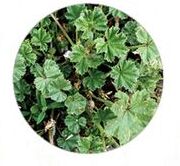 7. Mallow
7. Mallow
Mallow grows everywhere except Florida. Like moneywort, it can grow pretty low to the ground. However, the leaves have a different shape.
Instead of having small rounded leaves, the leaves are a bit larger. They also have somewhat jagged edges and are not round.
Can you eat mallow leaves?
Yes, mallow leaves are edible. They can be eaten raw in salads or cooked like spinach.
Is mallow weed poisonous to dogs?
Mallow is not poisonous to dogs. It is generally considered safe for pets.
How to get rid of mallow weed?
Start by manually pulling out the mallow plants, making sure to remove the entire root system. For ongoing problems, apply a post-emergent herbicide designed for broadleaf weeds.
Here are a few more steps to help:
- Hand-pull young plants as soon as they appear.
- Use a pre-emergent herbicide in early spring to prevent new growth.
- Apply a post-emergent herbicide to tackle established weeds.
- Keep your turf dense and healthy to discourage mallow weed from returning.
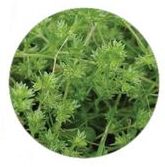 8. German Knotweed
8. German Knotweed
German Knotweed is common in coastal areas of the Atlantic and the Pacific northwest.
Like the name suggests, this weed has knotty looking leaves. It also has a rather stalky structure. The appearance of these weed is rather unsightly.
How to get rid of german knotweed?
To get rid of German knotweed:
- Manually remove by digging out the root system completely.
- Apply glyphosate-based herbicide directly to the plant during its growing season
- Regularly monitor the area and re-treat as necessary to prevent regrowth.
- Consider hiring a professional for persistent infestations or to ensure complete removal.
 9. Goosegrass
9. Goosegrass
Goosegrass is a grass. Like Quackgrass, it is different from the grass in your lawn.
It has thin stalks and long leaves. It can grow quite tall, and it definitely stands out against the background of your lawn. It grows in all areas but the Pacific northwest.
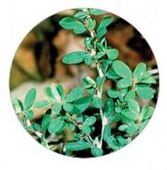 10. Japanese Clover
10. Japanese Clover
Japanese Clover grows only in the south.
This is a clover, but it is different from the traditional white clover. It grows rather tall, and it is quite stalky.
Can you eat Japanese clover?
Yes, you can eat Japanese clover (Kummerowia striata), also known as Japanese bush clover. It's often used in salads and as a cooked green.
How does Japanese clover spread?
Japanese clover spreads primarily through its seeds, which are dispersed by wind, water, and through attachment to animals and clothing.
How to remove Japanese clover?
Regularly mow the area to prevent the plant from seeding. For more extensive infestations, you can either apply a suitable herbicide or manually pull out the plants, making sure to remove as much of the root system as possible.
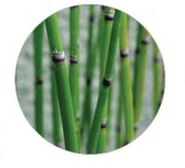 11. Horsetails
11. Horsetails
Horsetails grow everywhere but the southeast. They are quite stalky.
Their stalks are also different from a lot of stalks. The stalks have small black markings on them.
 12. Dallisgrass
12. Dallisgrass
Dallisgrass is common in the southern United States.
It is a tall grass, and it has long chutes. Unlike Quackgrass, it is fairly thin stalked with thin leaves.
How do you identify dallisgrass?
Look for clumpy growth, wide blades, and long seed heads on tall stalks. Dallisgrass has a coarse texture and grows in circular patches.
Is dallisgrass the same as crabgrass?
No, they are not the same. Dallisgrass grows in clumps and has wider blades, while crabgrass spreads outwards and has finer blades.
How to get rid of dallisgrass?
Getting rid of dallisgrass can be tricky.
Here are the most effective methods
- Pre-emergent herbicides: Apply in early spring before seeds germinate.
- Post-emergent herbicides: Target young dallisgrass plants. Multiple applications may be needed.
- Hand-pulling: Effective for small infestations. Remove the entire plant including roots.
 13. Dandelions
13. Dandelions
Dandelions grow everywhere in the United States.
They are very distinctive with the white "puffballs" that grow on the tops of them. In addition to growing the puffballs, dandelion flowers can also be eaten.
What does a dandelions look like?
Dandelions have bright yellow flowers and jagged green leaves. When mature, they produce fluffy, white seed heads.
How to get rid of dandelions?
The best way to get rid of dandelions is to dig them up, roots and all, with a weeding tool. If you've got a lot, a broadleaf herbicide can help.
For a more natural approach, try vinegar or boiling water. A healthy, thick lawn is your best defense against future dandelions
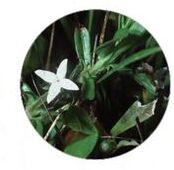 14. Virginia Buttonweed
14. Virginia Buttonweed
In the southeastern part of the United States, a plant called Virginia Buttonweed grows as a weed. This plant flowers. However, it is more unsightly than Speedwell.
It tends to be rather stalky, and it has long and dark colored leaves.
What is Virginia buttonweed?
Virginia Buttonweed is a persistent, perennial broadleaf weed commonly found in lawns and moist areas throughout the southeastern United States. It's known for its vigorous growth and resilience.
This mat-forming weed thrives in wet, poorly drained lawns, and features deep roots and rhizomes that help it spread.
How to prevent Virginia buttonweed?
To keep Virginia buttonweed at bay, focus on maintaining a healthy, dense lawn. Proper mowing, fertilizing, and watering are crucial.
Use pre-emergent herbicides in early spring to stop seeds from germinating, and apply post-emergent herbicides for visible weeds. Remove small infestations by hand, ensuring to remove the entire root system.
Identifying Weeds in a Nutshell
Weeds in your lawn vary across the US. Some, like White Clover and Yarrow, have distinct features and uses. Others, like Quackgrass and Dandelions, are widespread nuisances. They differ in appearance and regions they grow in.
At the end of the day, identifying weeds is not all that difficult, considering most of them are common.
Much like the type of grass in your lawn, identifying weeds is all about learning how to ID them.
For more great articiles on lawn care, check out our lawn care blog.





 Share
Share










